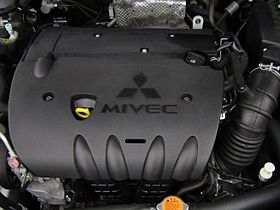Mitsubishi 4B1 engine
| 4B1 | |
|---|---|
 |
|
| Overview | |
| Manufacturer | Mitsubishi Motors |
| Also called | World Engine |
| Production | 2005–present |
| Combustion chamber | |
| Cylinder block alloy | Aluminium die cast |
| Cylinder head alloy | Aluminium die cast |
| Valvetrain | Direct acting DOHC, 16 valves, continuously variable MIVEC intake and exhaust valve timing |
| Chronology | |
| Predecessor | Mitsubishi 4G6 engine |
| Successor | Mitsubishi 4J1 engine |
The Mitsubishi 4B1 engine is a range of all-alloy straight-4 engines built at Mitsubishi's Japanese "World Engine" powertrain plant in Shiga on the basis of the Global Engine Manufacturing Alliance (GEMA). Although the basic designs of the various engines are the same, their exact specifications are individually tailored for each partner (Chrysler, Mitsubishi, and Hyundai). The cylinder block and other basic structural parts of the engine were jointly developed by the GEMA companies, but the intake and exhaust manifolds, the cylinder head’s intake and exhaust ports, and other elements related to engine tuning were independently developed by Mitsubishi.
All engines developed within this family have aluminium cylinder block and head, four valves per cylinder, double overhead camshaft layouts, and MIVEC continuous variable valve timing. All variations of 4B1 engine share the same short block. The difference in displacement is achieved by variance in bore and stroke.
The 4B1 engine family is the first to have the continuously variable valve timing MIVEC system applied not only to its intake valves but also to its exhaust valves. The intake and exhaust cam timing is continuously independently controlled and provide four optimized engine operating modes.
The engines's bore and stroke both measure 86.0 mm, which engineers refer to as square. According to Mitsubishi, the new cylinder dimensions contribute to a free-revving character (max power at 6,500 rpm), linear power delivery and wide torque curve. Mitsubishi used a timing chain instead of a belt for better reliability and iridium spark plugs to lower emissions and to help extend major service intervals for lower cost of ownership. To reduce weight, Mitsubishi used a plastic cam cover and intake manifold and double-layer stainless steel exhaust manifold. The exhaust manifold has a rear location on the transverse engine, compared to the front location for the previous engine, yielding important benefits such as better emissions performance. To lower vibration, Mitsubishi used a 4-point inertial axis system with cylindrical hydraulic engine mounts on the left and right sides. A lightweight, high-rigidity squeeze-cast aluminium bracket on the right side mount (engine side) lowers engine noise under acceleration. A lightweight, high-rigidity steel plate bracket on the left side mount (transmission side) lowers gear noise. A custom-tuned insulator was developed for the front and rear mounts to help control both idle vibration and acceleration shock.
...
Wikipedia
